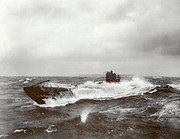Amsterdam (1748)
18th-century cargo ship of the Dutch East India CompanyThe Amsterdam was an 18th-century cargo ship of the Dutch East India Company. The ship started its maiden voyage from Texel to Batavia on 8 January 1749, but was wrecked in a storm on the English Channel on 26 January 1749. The shipwreck was discovered in 1969 in the bay of Bulverhythe, near Hastings on the English south coast, and is sometimes visible during low tides. The location in 1969 was found by Bill Young, the site agent/project manager for the sewage outfall being built by the William Press Group. With time on his hands during the long stay away from home, he followed up the rumour of the going aground. He was castigated by the Museum of London for scooping out the interior of the bow with a digger as it could have led to the structure collapsing. However, it uncovered the initial items which led to a more extensive excavation of the cargo which reflected life at the time. The wreck is a Protected Wreck managed by Historic England. Some of the findings from the site are in The Shipwreck Museum in Hastings. A replica of the ship is on display in Amsterdam.










